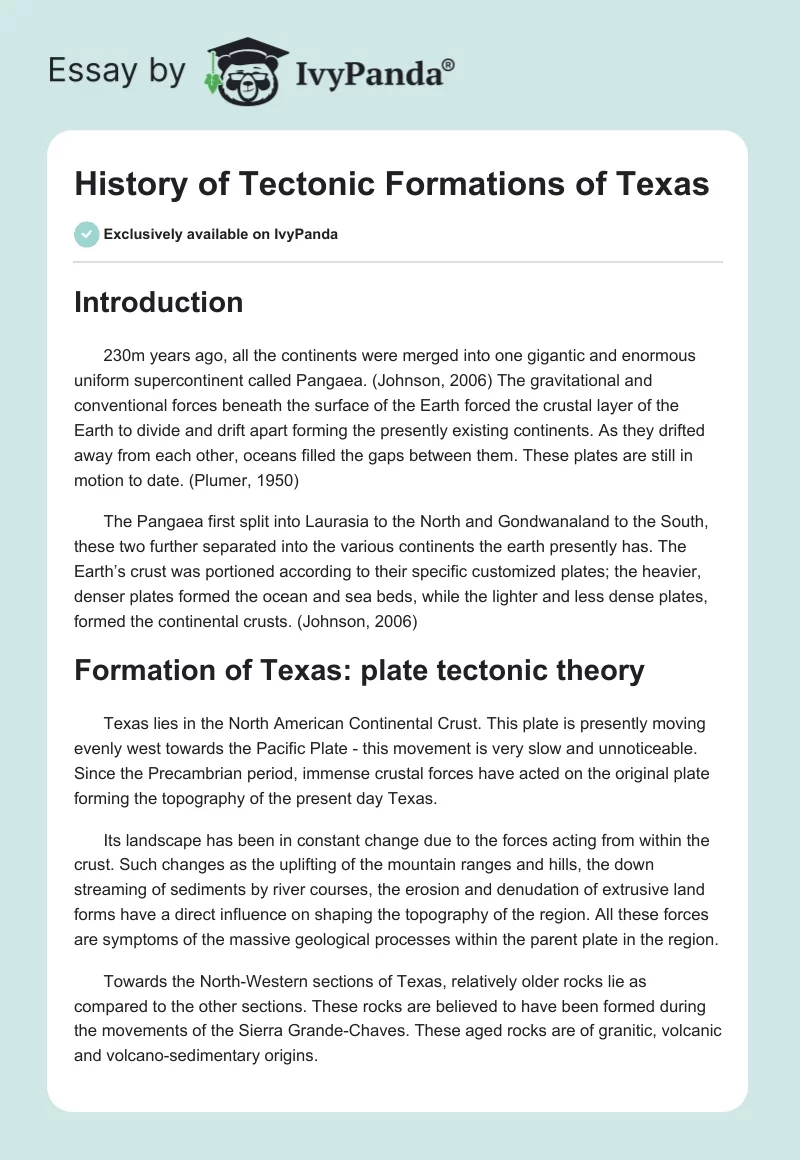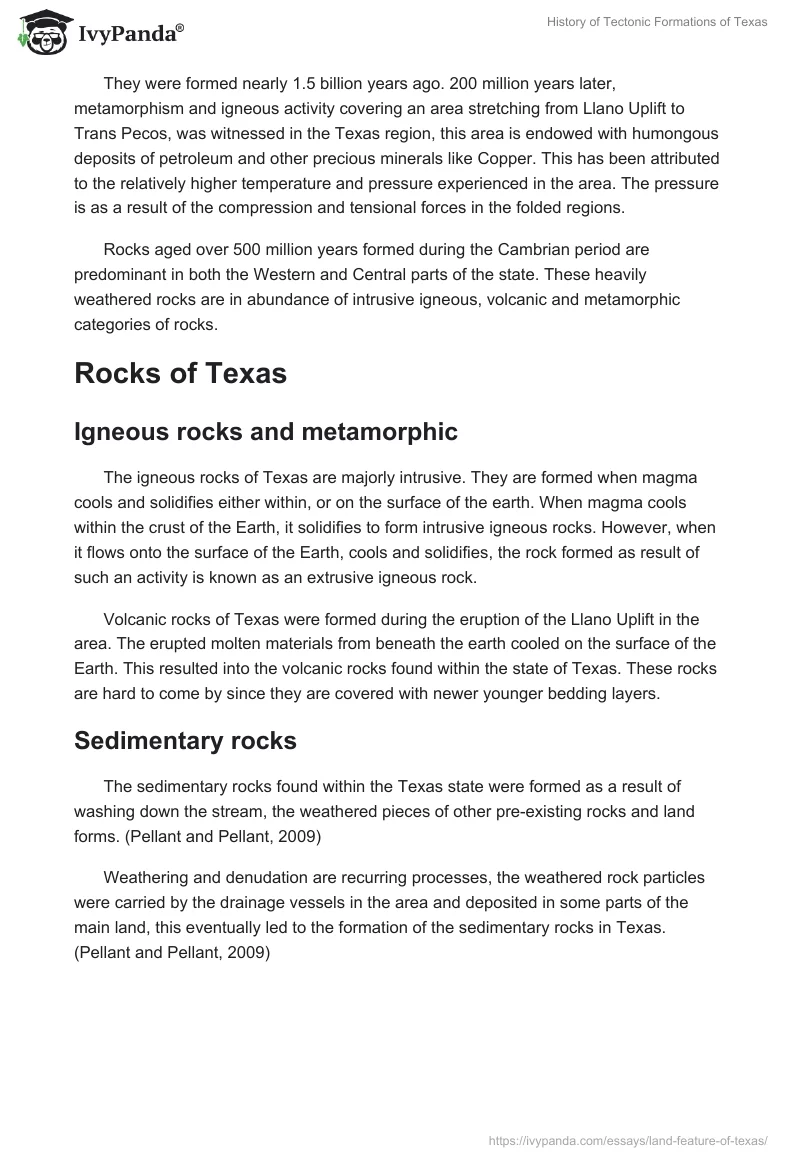Introduction
230m years ago, all the continents were merged into one gigantic and enormous uniform supercontinent called Pangaea. (Johnson, 2006) The gravitational and conventional forces beneath the surface of the Earth forced the crustal layer of the Earth to divide and drift apart forming the presently existing continents. As they drifted away from each other, oceans filled the gaps between them. These plates are still in motion to date. (Plumer, 1950)
The Pangaea first split into Laurasia to the North and Gondwanaland to the South, these two further separated into the various continents the earth presently has. The Earth’s crust was portioned according to their specific customized plates; the heavier, denser plates formed the ocean and sea beds, while the lighter and less dense plates, formed the continental crusts. (Johnson, 2006)
Formation of Texas: plate tectonic theory
Texas lies in the North American Continental Crust. This plate is presently moving evenly west towards the Pacific Plate – this movement is very slow and unnoticeable. Since the Precambrian period, immense crustal forces have acted on the original plate forming the topography of the present day Texas.
Its landscape has been in constant change due to the forces acting from within the crust. Such changes as the uplifting of the mountain ranges and hills, the down streaming of sediments by river courses, the erosion and denudation of extrusive land forms have a direct influence on shaping the topography of the region. All these forces are symptoms of the massive geological processes within the parent plate in the region.
Towards the North-Western sections of Texas, relatively older rocks lie as compared to the other sections. These rocks are believed to have been formed during the movements of the Sierra Grande-Chaves. These aged rocks are of granitic, volcanic and volcano-sedimentary origins.
They were formed nearly 1.5 billion years ago. 200 million years later, metamorphism and igneous activity covering an area stretching from Llano Uplift to Trans Pecos, was witnessed in the Texas region, this area is endowed with humongous deposits of petroleum and other precious minerals like Copper. This has been attributed to the relatively higher temperature and pressure experienced in the area. The pressure is as a result of the compression and tensional forces in the folded regions.
Rocks aged over 500 million years formed during the Cambrian period are predominant in both the Western and Central parts of the state. These heavily weathered rocks are in abundance of intrusive igneous, volcanic and metamorphic categories of rocks.
Rocks of Texas
Igneous rocks and metamorphic
The igneous rocks of Texas are majorly intrusive. They are formed when magma cools and solidifies either within, or on the surface of the earth. When magma cools within the crust of the Earth, it solidifies to form intrusive igneous rocks. However, when it flows onto the surface of the Earth, cools and solidifies, the rock formed as result of such an activity is known as an extrusive igneous rock.
Volcanic rocks of Texas were formed during the eruption of the Llano Uplift in the area. The erupted molten materials from beneath the earth cooled on the surface of the Earth. This resulted into the volcanic rocks found within the state of Texas. These rocks are hard to come by since they are covered with newer younger bedding layers.
Sedimentary rocks
The sedimentary rocks found within the Texas state were formed as a result of washing down the stream, the weathered pieces of other pre-existing rocks and land forms. (Pellant and Pellant, 2009)
Weathering and denudation are recurring processes, the weathered rock particles were carried by the drainage vessels in the area and deposited in some parts of the main land, this eventually led to the formation of the sedimentary rocks in Texas. (Pellant and Pellant, 2009)
The importance of the rocks
The rocks within the Texas State have numerous uses. These rocks have great significance to the economy of Texas. These include the under listed:
- From the rocks, the state extracts minerals; examples are feldspar, sulfur, potash and phosphate. These minerals are sources of revenue for the federal government.
- The folded rocks of Llano Uplift are rich in petroleum deposits that the state can easily harness. (Plummer, 1950) The petroleum is very essential in running several industries
- The availability of the minerals has led to the emergent of industries that use them as raw materials; this has led to the creation of employment opportunities for the citizens e.g. soda ash mining in the Southern Texas.Bottom of Form
- The western part of Texas is endowed with Uranium minerals. The deposits of this precious element have been very significant in the sustenance of the nuclear enrichment program in the United States.
- From the regions of Uvalde to Texacarna, there exists huge deposits of copper which have greatly assisted in earning foreign exchange and supporting other related industries
- Support of the construction industry. The rocks are used as materials in building and construction
References
Johnson, R. L. (2006). Plate tectonics. Minneapolis: Twenty-First Century Books.
Pellant, C., & Pellant, H. (2009). Rocks (U.S. ed.). Pleasantville, NY: Gareth Stevens Pub.
Plummer, F. B. (1950). The carboniferous rocks of the Llano region of central Texas. Austin: The University of Texas publication.


